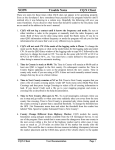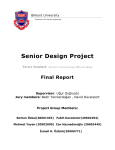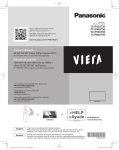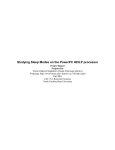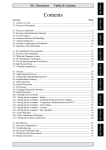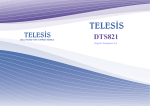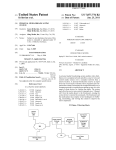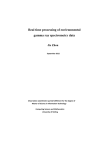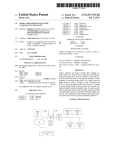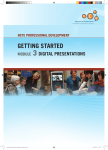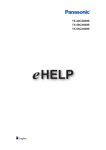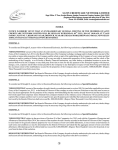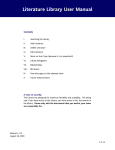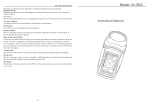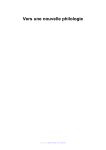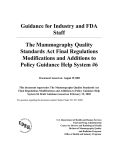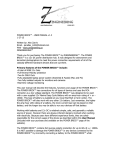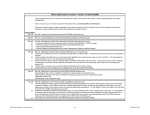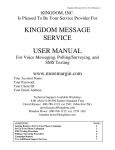Download Writing A User Manual (part 1)
Transcript
Writing A User Manual (part 1)
(2002-12-27) - Contributed by Deepa L, (c) Melonfire
Need to write a user manual, but don't know where to start?
Our handy two-part guide takes you through the process, explaining the
importance of proper planning in the early stages and demonstrating how
to build a consistent and usable stylesheet for document formatting.
Depending on who you speak to, documentation is either the best part of
a software project...or the worst.
Most developers wouldn't be caught dead writing a user manual - they
much prefer spending their time building better, more efficient
algorithms. Their users, on the other hand, don't really care about the
code that powers a software application; they're more interested in
getting their work done quickly, with minimal errors.
That's where support documentation, in the form of a user manual, comes
in. Usually considered one of the least important deliverables, it is
slowly coming of age, as software companies begin to realize the value
of high-quality documentation that answers most user questions and
reduces after-sales support calls (and expense).
Support documentation allows the user to use the delivered software with
ease and efficiency. Ideally, it comprises:
- Interface text: The labels on interface elements like menu items,
fields, instructions, confirmations, error messages et al.
- Application messages: Operational error messages and warnings.
- Online documentation: Online help, tutorial and searchable help
pages.
- Print documentation: User manual and technical reference manual.
These, in totem, are the user's support system for usage of the
software.
This article focuses on the user manual, explaining, from a technical
writer's perspective, the process by which such a manual is developed,
reviewed and delivered. I believe, though, that the process and planning
tips are generic enough to apply to the other print documents, in
accordance with both their purpose and scope.{mospagebreak title=Step By Step} One of the first decisions project
managers face is whether the user
manual should be a development team production, or whether a technical
writer should be assigned the job. Practically, this decision is a
function of the size and budget of the project, but an understanding of
a technical writer's contribution helps in making an informed choice.
While the developer's responsibility is to be an expert on the
structure, features and working of the software, the technical writer is
responsible for understanding the users' mindset - their expectations,
present level of expertise and possible questions - and then formulating
the best way to communicate with them. The quality (ability to
communicate) of the support documentation directly affects the level of
after-sales support required. Since technical writers are trained in the
black art of communication, it usually makes more sense to hire one for
the support documentation needed, rather than have a developer do it.
Documentation, as a process, begins (ideally!) right at the point where
the development team has finalized the software design, because:
- That provides enough fodder for you, the writer, to start planning
the structure of the manual.
- You have a better chance of understanding the software if you ask
http://www.devshed.com - Dev Shed
Generated: 25 February, 2008, 10:33
questions (lots of them!) while it's still in development.
Post-development, the team is usually into the next project, and you end
up doing a lot of backtracking and guesswork.
- The project schedule will typically never allow time between
development and delivery for anything more than very superficial
documentation.
- Most important, the ideal scenario is to release the documentation in
time for the software testing, so that the test team tests the documents
as well as the software simultaneously.
An organized process of documentation will usually have the following
phases:
- Planning
- Stylesheet creation
- Development
- Review
- Version management
- Delivery
In this article, I'll be focusing on the first two steps, with a list of
things you should keep in mind when formulating the structure and style
of your manual.{mospagebreak title=Asking The Hard Questions}
You should start thinking about the user manual right at the start, and
try to have the following questions answered by the time you actually
get down to writing it.
1. Who is the audience?
This helps you decide the tone and level of technicality of your
language, the depth in which the concepts need to be explained, and
(very important) the analogies that you can use (familiar ground is best
when trying to explain something new). Knowing the following parameters
about the intended users would help:
- What is their average age?
- Which computer software packages are they familiar with?
- What are the obstacles they usually experience while using these
software applications?
- What are the top five task(s) they plan to use your software for?
- What is their current level of expertise (novice/intermediate/expert)
in using particular software packages?
This information is useful when your software builds on existing
software currently in use. For example, if you are delivering an
intranet email utility that plugs in to Microsoft Outlook, it would make
sense to find out if your audience has ever used it, and to what level.
This also brings up an important decision: do you decide the minimum
technical expertise required of the users of your software, state it as
such in the user manual, and get on with things? Or, given the results
of your user profiling, do you take on the responsibility of bridging
the gap between the current and required level of expertise (maybe by
providing a short tutorial as a precursor to the manual)? The schedule
and budget would normally make this decision for you.
The ideal scenario, of course, would be that you get all this
information by interviewing the actual users. In case that isn't
possible, your marketing and QA departments should have the requisite
http://www.devshed.com - Dev Shed
Generated: 25 February, 2008, 10:33
insight into the target audience.
Besides this, some research into the business processes of the target
organization will give you even greater insight into the context of user
tasks, as well as fodder for analogies that may be easily understood y
them. Additionally, customer meetings, including technical reviews, are
great sources of audience information.
2. What is the scope of the document?
While the broad goals of the user manual would be to provide information
on the installation, usage, administration and troubleshooting of the
product, questions like these would help scope the document further:
- Current user expertise versus required expertise: What is the extent
of background/explanation that needs to be given?
- Supported platforms: What are the different platforms/operating
systems that the manual should address?
- Troubleshooting: What level of troubleshooting are the users supposed
to handle? Is there a reporting mechanism for support? Is there separate
documentation for troubleshooting?
3. What tool should you use for document development?
The user manual, online help and searchable help essentially build on
the same information. Which means that your choice of tool, and its
ability to allow you to reuse information from one document for the
faster development of another, is crucial (especially if your project's
on a tight schedule).
A number of good tools are available for this purpose. I like RoboHelp
(http://www.ehelp.com/), though if you're working with XML, you should
also look at the XMLMind XML Editor (http://www.xmlmind.com/)
4. What is the mode of document delivery?
The user manual can have two modes of delivery and distribution:
- Print: In this case, you take the responsibility of printing it
in-house and delivering it to the customer (many customers demand this).
The
downside: you get to incur printing and distribution costs (and the
accompanying logistical issues), together with recurring costs every
time the documentation is revised.
- Electronic: In this case, you may choose to deliver documentation in
electronic format, via CD-ROM at installation time, or provide
downloadable material on your Web site. The de facto standard for such
electronic documents is Adobe's Portable Document Format (PDF).
Again, if you're not sure what the final format will be, and if you're
comfortable with XML, it's worthwhile considering developing your
document in XML; this may then be easily converted into any other format
at a subsequent stage.{mospagebreak title=Making Friends And Influencing People} Another important aspect of
planning is figuring out your resource
requirements, especially if you are a technical writer expressly brought
in to the project for support documentation. There are a number of
resources you can tap - here's a brief list:
1. SMEs: SMEs (Subject Matter Experts) are your guides throughout the
documentation project. These are usually members of the development team
who will familiarize you with the application, answer your questions and
http://www.devshed.com - Dev Shed
Generated: 25 February, 2008, 10:33
generally be your information bank. This is a good time to determine
which developers from the team are to be your SMEs.
Your relationship with the SMEs will go a long way in determining the
success of this task.
- Determine a method of communication that is suitable to both. An
option is that you post your questions to the SMEs via e-mail, who may
then respond in their spare time, or (if the explanation is long-drawn)
schedule a meeting.
- Ask the right questions. Understand that on the other side of your
question lies a lot of information, and what you get to know will be in
direct response to only what you ask. So, spend some time getting your
questions right.
- Get familiar with the platform and terminology used in the software.
This way, again, you make your meetings with the SMEs efficient.
- Let the SMEs know that you need to know of every change made in the
project; any change in the software that affects flow, functionality or
interface affects your document. In fact, even with changes that don't
affect the user interface, it's a good idea to be in the loop, because
there could be reactions that you would want to know about. Again, try
and set up an information chain or e-mail trigger for the same.
2. Project specifications: Needless to say, getting acquainted with the
specification documentation is crucial to understanding the project. The
objective of the project from the customer's business point of view is
usually defined very clearly in these - make sure you re-use that, as
your users will relate to it.
3. Prototype: Since you're going to be writing about the behavior of
each feature in the software, playing around with the actual interface
is a must. On the other hand, documentation usually begins in parallel
with development, so you don't really have anything to go by.
The workaround here is the prototype. The delivery of the prototype by
the development team will be a big milestone in your schedule...because
that's where you actually start developing the manual. Get this date
from the developers, and circle it in your calendar.
Note also that changes take place frequently in the early stages of
development, not only in the behavior of the software, but also in the
interface elements, text labels and messages. Ensure that your manual
reflects the delivered product by referring to the latest prototype.
4. Schedule: The cornerstone of this planning stage is the schedule. An
important consideration here is the dependencies between your tasks and
other milestones in the schedule. Understand the developers' schedule
and build your own based on that. Your milestones could be something
like this:
- User profile generated
- Product information assimilated from specifications
- Stylesheet finalized
- Table of contents/outline complete
- Outline sent for review
- Outline returned with comments
- Comments incorporated and outline available for sign-off
- Sign-off
- First draft sent for review
- First draft returned with comments
- Comments incorporated and draft available for sign-off
- Sign-off
http://www.devshed.com - Dev Shed
Generated: 25 February, 2008, 10:33
- Second draft sent for review
- Second draft returned with comments
- Comments incorporated and draft available for sign-off
- Sign-off
- Third draft sent for review
- Third draft returned with comments
- Comments incorporated and draft available for sign-off
- Sign-off
- Delivery
Review and revision efficiency (addressed in the second part of this
article) are crucial to ensuring that three drafts are all it takes.{mospagebreak title=Being Conventional} Conventions in
the document lead to patterns that the users can grasp.
They then start expecting information in a particular format, thus
increasing their level of comfort with the document. Using consistent
styles also speeds up assimilation of the information, and helps spot
particular information easily on re-reads.
- Headings: Headings are a powerful tool in making a huge mass of text
look manageable. A common model is that as you go deeper in a particular
topic, you indicate that by descending prominence of headings. So, all
top level headings will be, say, in a large font size and bold typeface,
with the next level taking a smaller font size, and so on. You might
also want to number the headings to help users understand the grouping
of information.
- Styles: While a short piece of text requires only minimal use of
styles (bold for highlighting, underline for warning), a tome as
voluminous as a user manual needs you to be much more creative. You
could set conventions for indicating screen names, interface text or
text that the user needs to input.
On the other hand, too many conventions negate the purpose - remember,
they should assist in quick reading and lookup, and they won't if users
have to keep recollecting what a particular style indicates.
- Indented text and footnotes: This is text that is peripheral to the
point that you are making - for example, background information on a
concept that you're introducing or a warning related to some functional
step that you're explaining. Add these when you don't want to distract
the user from the main flow of information.
- Bullets and numbering: Bullets and numbering can also help to break up
complex concepts into simpler, smaller information nuggets. The
convention here is to use numbering for sequential information only (for
example, steps to perform a task) and bullets for other related
information that is best presented in points instead of a paragraph.
Bullets also allow you to group together points related to a concept and
ascribe them levels of importance. Much care and consideration should be
given to the grouping of information in this manner - it could easily be
as confounding as useful.
- Terminology: A very, very important rule of creating end-user
documentation is to be consistent in your use of words. For example, if
you're using the word "function" to indicate the, well, functions of
your software, you shouldn't at any point switch to "features",
"commands", "menu items" or "actions". To this end, make yourself a
glossary of the terms that you're going to use right at the start, and
stick to them consistently.
- Images and illustrations: Sometimes, a picture really is worth a
thousand words - and screen grabs, schematics or flow diagrams can
substantially increase the efficacy of your document. Plan your usage of
http://www.devshed.com - Dev Shed
Generated: 25 February, 2008, 10:33
images and illustrations in advance, and be consistent in their usage
and labeling.
So that takes care of preparation - all that's left now is to actually
begin work. In the next, and concluding, section, I'll be discussing the
process of actually developing the structure of the manual, together
with a sample table of contents, and also spending some time on document
revisions, version management, and delivery. Make sure you come back for
that!
Note: Examples are illustrative only, and are not meant for a production
environment. Melonfire provides no warranties or support for the source
code described in this article. YMMV!
http://www.devshed.com - Dev Shed
Generated: 25 February, 2008, 10:33
Dev Shed
02/25/08 10:36:15
Practices
Writing A User Manual (part 2)
Contributed by Deepa L, (c) Melonfire
2003−01−03
The Slingbox AV is the perfect companion for your DVR, digital cable, or satellite receiver. It allows you to watch and control live TV, or
any other TV entertainment you have, anywhere you go. Save $10!
In the first part of this article, I introduced you to the process of creating a user manual, illustrating the groundwork you
need to do prior to actually beginning work. In this concluding article, I'll take you through the development process,
demonstrating a sample TOC and giving you a few tips on the review and version management stages of the process.
Once you've got your stylesheet done, you've finally reached the point of production − where you actually start creating
the document. Generally, the best way to go about it is to create the bare−bones structure (TOC), have it approved, fill in
the peripheral information (overview, scope, conventions used, glossary) and then move in to the meat of the matter. This
is also the time (ideally!) when the prototypes are finally ready for you to start working with.
The following is a generic user manual structure:
1. Introduction
♦ The product − introduce the product to the user.
♦ The user manual
◊ Scope/Purpose
◊ Flow
◊ Conventions
◊ Glossary
2. Installing the software (assuming it's not a separate guide)
♦ System requirements
◊ Platform Support
♦ Information/resources required in the process of installation
♦ Installation steps
At this point there is usually a decision to be made about how to depict installation procedures for different platforms. The
main criteriion here is how different the procedures are − if the steps are drastically different, you will have to explain the
procedure separately for each platform. But if the steps are not very different, you could choose the most common
platform as your base, and wherever the steps are different, indicate the steps for the different platforms as indented text.
3. Using the software
♦ Introduction
◊ Purpose of the software
◊ What it does and does not do (list the exact tasks)
◊ User levels and the implications (segregate the user and admin level tasks)
♦ Best configuration (for example, best viewed in 640x480 resolution)
♦ Invoking the software
♦ Interface elements
♦ Steps to perform the required tasks
4. Administration
♦ Reiterate the administration level tasks
♦ Segregate (if possible) into administration, maintenance and troubleshooting functions, and then get into
1/4
Dev Shed
02/25/08 10:36:15
explanations
♦ Always lead in to a task with scenarios (for example, you need to shut down the server over the weekends
and at the end of the day − here's how...)
♦ Also, try and bring out exceptional scenarios at the same time (to continue the above example, the
administrator would not shut down the server over the weekend if there has been a request for remote
access by one of the users)
5. Troubleshooting
♦ For each error condition describe:
◊ What happens on the display
◊ The error message displayed
◊ What it means and what is the implication with respect to the attempted action (for example, the
user will have to re−enter information)
◊ Steps to take to rectify the error
6. Appendix
An appendix allows you to expound on peripheral information that would be detracting when given in the main
body. Detailed diagrams, flow charts, or references to books/tutorials on related software could be included here.
Here are some quick tips to assist you in developing this structure:
• Be visual: The most comforting thing for the user will be to see on screen what they've seen on the manual's
pages, or vice−versa. Try and use screen grabs and small schematic diagrams wherever appropriate.
• Importance of relevant analogies: Essential if your software introduces concepts new to the user.
• Use of transition words: "because", "therefore" and "consequently" are powerful words when talking about
cause−effect relationships that the user isn't aware of.
Once you're done with filling in the details, it's time for a review. The review is a crucial process for any document, and
more so for the user manual. You are dependent on the SMEs for verification of the technical information, on peer writers
for editorial comments on structure and flow, technical support guys for evaluation of whether you've covered the most
common support requests, and − of course! − a sample set of actual users to tell you whether it works.
But before you get to the point where you release drafts for review by these groups, you need to review the document
yourself. Here's a quick cheat sheet that assists in this process:
1. Is all the information there? Have all the key terms been defined? Are instructions to cover all tasks there?
2. Is the usage of paragraphs appropriate? Are they too long? On the other hand, guard against the paragraphs being
so short and abrupt that the information seems unrelated.
3. Does the flow make sense?
4. Are the levels logical? Is the grouping together of modules sensible?
5. Are the descriptive headings apt? Could there be a summary at the beginning and end of each section to guide the
user better?
6. Are there inconsistencies in usage of terms?
7. Is the tone consistent throughout? Are you shifting from the first to the third person and back again?
8. Are all topics covered to a consistent level of depth? Sometimes, at the time of writing, you may not have the
same level of information on all topics covered (or you may just have been in a hurry to get the job done). This
difference is very noticeable, and looks sloppy − watch out for it and fill in the consistent level of detail.
Once you've covered this ground, you can release the draft for review by the others involved. A thorough review needs a
lot of commitment and time. You will need to make it easier for your reviewers by including quick cheat sheets stating
what they should be looking for. An example cheat sheet for the SMEs would be:
1. A technical review is not an editorial review.
2/4
Dev Shed
02/25/08 10:36:15
2. Focus on the technical facts to verify that the technology works as documented.
3. Verify the technical accuracy of all procedural steps included in the document.
4. Verify the technical accuracy of all screen captures in the document.
User reviews are a tad trickier than the others are because of the lack of resources. First, you may not have access to the
actual users to review your document. And second, they may not really be motivated at that point to take the time to
review your document. The workaround is to use your marketing and QA departments, and perhaps the people from the
customer's end who are involved in the project.
Once the reviews are in, you need to get down to implementing the changes suggested. One tip would be to start revision
on a document only after all the review comments are in. Also, while we won't get into the art of accepting feedback, you
have to be in control of the changes that you agree to make. While you can change the information quite a bit at the time
of the first review, you should try and restrict your changes to corrections only after the second review; structural changes
this late in the process will throw you off. A characteristic of documentation is that if you notice even one inaccuracy in a
document, it will put you off going through the rest of it. The gravity of this increases manifold when you're talking about
a user who's looking to this document to understand your software. Ensuring that your manual reflects the latest version of
the software is crucial, and this is where tying the document version number with that of the software comes in.
Another consideration here is version nomenclature. You could tie this in with the software, using x.y nomenclature that
has x changing with every baseline change and y changing for every intermediate release of the document. Also, when
you revise the document, you should record the reason/description of the change in the document's revision log. With all
of this behind you, you will finally be ready to release the manual. The following frills will complete the package:
1. Cover page
♦ The name of the software should be written in accordance with the brand decided.
♦ The version number of the software should be clearly stated.
♦ The name of the developer with address and contact numbers.
2. Table of contents
♦ The topics should be linked to the matter inside.
3. Notifications for proprietorship and confidentiality
4. Headers and footers
♦ Headers could include the project name and version number of the document.
♦ Footers can have the page numbers and a short confidentiality notice.
It might also be a good idea to include a feedback form as the last page, as your users will probably get back to you with
suggestions. This will be especially useful if there is a second phase of development for the software.
And that's about it. If you'd like to learn more about the technical writing process in general, here are some links you
might find useful.
Developing documentation without a tech writer, at
http://builder.com.com/article.jhtml?id=u00320020510gcn02.htm&vf=ra
The Seven Deadly Assumptions of Technical Communication, at
http://www.williamrice.com/techcomm/sevenassumptions/7assump1.html#Assum ption1
Online Technical Writing − An Online Textbook at http://www.io.com/~hcexres/tcm1603/acchtml/acctoc.html
Happy writing!
Note: Examples are illustrative only, and are not meant for a production environment. Melonfire provides no warranties or
3/4
Dev Shed
02/25/08 10:36:15
support for the source code described in this article. YMMV!
DISCLAIMER: The content provided in this article is not warranted or guaranteed by Developer Shed, Inc. The content
provided is intended for entertainment and/or educational purposes in order to introduce to the reader key ideas, concepts,
and/or product reviews. As such it is incumbent upon the reader to employ real−world tactics for security and
implementation of best practices. We are not liable for any negative consequences that may result from implementing any
information covered in our articles or tutorials. If this is a hardware review, it is not recommended to open and/or modify
your hardware.
4/4










